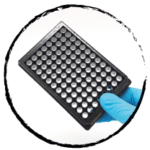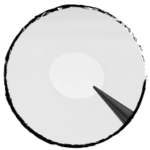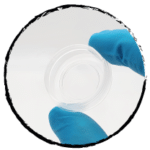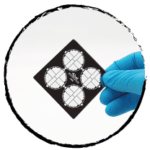PREPARING THE SLIDE
1. Make sure there is no dust: wash the slides in absolute ethanol and dry them. Use wipers to absorb any remaining droplets.
2. Using the deep UV Printer, activate the slides for 5 min. You can put the slides on a microscope slide or any glass support to avoid contact with the bottom of the lamp box. Directly use the slides after activation.
3. Incubate 30 min in PEG at room temperature: add 50 µL of the PEG solution (yellow tube) on a parafilm.
Put the activated side of the slide on the drop!
4. Remove the slides with tweezers. Rinse the PEG with distilled water in a Fluorodish or a 6-well cell culture plate. Place the activated side facing you and add water on the edge of the well. Wash twice. Take the slides with tweezers. Let the drop drip down the glass. Use a paper to absorb any remaining droplets. Be careful not to touch the activated side with paper.
You can also use the dipper to facilitate the PEG treatment.
UV ILLUMINATION
1. Wash the 4Dcell quartz mask with absolute ethanol. To dry it, you can either air dry or use wipes.
2. Using the deep UV Printer, illuminate the 4Dcell mask 10 min with its brown side facing the lamp. This makes the brown side of the mask hydrophilic.
3. Add 3 µL of millipore H2O onto the brown side of the 4Dcell quartz mask. Place each drop of 3µL on the edge of a circle defining the patterns.
4. Gently drop off the PEGylated side of the slide on the mask. Start to place the slide near the water drop and slowly drop it off on the circle where the micropattern is. You can use a plastic tip to press the slide against the mask and thereby spread the drop and avoid any bubbles.
5. Using the UV Printer, illuminate the 4Dcell mask 10min with the silver side facing the lamp.
6. Add 5 mL of distilled water on the mask to help detach the slides from it. Let it incubate for 5 min.
7. Take off the slide with tweezers. You can bring the slide to the closest edge of the mask. Be careful not to scratch the mask, and catch it with tweezers.
8. Incubate the activated side 1 h at room temperature with a combination of fibronectin and fibrinogen: on a parafilm, add 50 µL of fibronectin (blue tube) and 10 µL of fibrinogen (green tube), mix them with your micropipette and let your slide incubate.
9. Rinse with water. You can stock the slide in a fridge at +4°C.
You can also use the Micropatterns Masker to improve the quality of the contact between the photomask and the slides.
PLATING OF THE CELLS
1. Prepare 100.000 to 200.000 cells for each 25 m.
2. Detach the cells.
3. Centrifuge cells to get rid of the medium used to detach cells.
4. Resuspend cells in 1 mL of the culture medium for each slide (mix extensively with a 1 mL pipette to separate
the cells from each other): put your slide in a petri dish with the patterned side facing you. Add the culture medium onto the slide with the micropipette.For high quality cell imaging, you can use the magnetic chamber.
5. Wash the unattached cells 20-30 min after plating with equilibrated hot medium, without serum in it.
Cells should be spread on the patterns 1 h after plating.
For this step, the time depends on the type of cells used and in which conditions.
OTHER PRODUCTS RELATED TO MICROPATTERNS




